Caitlin Doughty's Blog, page 9
November 3, 2020
America’s First Cremation Was WILD
October 15, 2020
Why Are Ghosts So White?
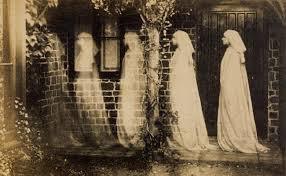
I have a lot of experience with ghost stories. I’m a folklorist and professor at East Carolina University in Greenville, North Carolina, where I teach a popular class called The Supernatural.
My class, isn’t focused on proving or disproving experiences, rather we focus on what they mean and why they are told. For me, that means that some of my research on the supernatural deals with why we care so much about ghosts, spirits, cryptids, and all other manner of paranormal creatures.
In my classes we tend to see the opposite of most people’s experience in telling and researching ghost stories. There are no whispers in dark corners at parties, no campfires, no secrets over coffee or stronger drinks. We tell these stories under the bright florescent lights of a university classroom, where we discuss their importance and deconstruct what they mean. There’s something odd about discussing poltergeists at 8:00 am, something that makes these stories even more fragile and wrought with tension.
As we see frequently with paranormal stories in official spaces, at least for some cultures in North America, there’s a fear of derision, but we create a safe space and we tell them all the same. Trust me when I say the students want to share and hear stories – they are, pardon the pun, dying to tell me about their experiences. They’re not used to environments, especially academic ones, without judgement. Many of them come from backgrounds where the supernatural is either not believed or not allowed to be discussed. The students who haven’t experienced the paranormal are often a combination of jealous and terrified (and those who have an experience during the duration of the class or previous to it often report that they wished their supernatural experience never happened). We talk about strange noises, objects moving, footsteps, voices, and strange feelings, things that you’re not supposed to talk about, especially in a university classroom. But no matter how deep we get, or how close these stories make us feel to each other, we still have trouble discussing why all of these ghosts are so white and why the rare ghosts of color are stereotypes of stereotypes, tropes that would be unbelievable in a movie and openly shamed if we were talking about popular culture.

A still from the documentary “The Long Shadow.”
The ghosts here on campus, as they are in many other places, are not very diverse. This is surprising given our town’s population, which while still majority white (about 60%), has large Latinx, Indigenous, and Black communities. My classes do not always reflect this diversity and I’m often lucky to see 5-6 non-white faces in a class of 40.
On campus we have the story of a woman who hung herself after a bad breakup, a confederate soldier who haunts a Kristy Kreme, a theater ghost who wants to give just one more performance, and all of these ghosts are presumed white. Every single one of our Black ghosts were enslaved people, while our Indigenous ghosts are wholly absent with the exception of a place vaguely described as an “Ancient Indian Burial Ground” instead of any representation of an individual person.
I’ve heard stories of a mysterious presence in a local apartment that folds the clothes and tidies the rooms of white college women (presumed to be a formerly enslaved female, who “wants to help them”). When we discuss plantations, I hear stories about the ghosts of enslaved people still haunting locations where they were worked to death, who are now tortured in the afterlife by the ghost of the slaveowner or overseer.
So many of these stories highlight the centrality of white narratives, which is often painfully obvious in stories that white people tell about BIPOC. Many of their stories about enslaved people and “Indian princesses” say much more about their culture than it does about the non-white people in their stories. There is no acknowledgement of death as freedom for many enslaved Africans or the beliefs expressed in Indigenous narratives. Even the structure of these narratives has the clear mark of whiteness on it.

Ghost, c. 1935, Kodak Collection, Science Museum Group collection
After giving a Nerd Nite talk at a local brewpub, a woman told me about the ghost of a man who was lynched. I was surprised to hear this story for the first time after almost a decade of living here. When I asked my students about it, they told me they did know a story about a local “hanging tree” (“lynching tree” I corrected them) where if you park underneath it and honk the horn, you’ll hear the feet of the man hung (lynched, I remind them again) brushing the top of the car. The students looked down, not wanting to make eye contact and refusing to engage until I move on to demonstrate the similarity between this ghost story and the legend of the Boyfriend’s Death. It was clear that those sorts of ghosts were not available for discussion. I press further, later on in the semester, but still nothing. Students who trust me with their most intimate stories, stories they’ve often never told anyone else, will not speak about race.
Even when I take students abroad to London to talk about ghosts there, the ghosts are white. London, one of the most multicultural cities in the world, is filled with white ghosts. The ghosts of queens and princes, ghosts with questionable names like “Scratching Fanny” and “The Screaming Spector,” theatre ghosts, but all white ghosts (at least, the ones who have, well had, bodies). The ghosts of London often match what the students think of London: all double-decker busses, royalty, and beefeaters. They frequently haven’t heard of the Windrush Generation or even the refugee camps at nearby Calais until we took them to a production of The Jungle, a play depicting life in a migrant camp, which left the students unable to speak.
Ghosts reflect how we see the dead and how we understand a place. On campus ghosts give us a sense of history and tales of warning. On study abroad they teach us about the people and history of a new place, and reinforce every single stereotype that we work so hard to deconstruct.
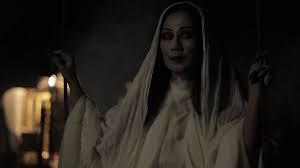
International travel is supposed to be eye-opening, but even the ghost tours cover up the worst of what’s happened, even while they’re telling stories of murder and death. Many see ghost stories as mere entertainment, as a tourist activity, something to give us a chill and send us on our way knowing that we’re safe….for now. However, we need to think more about those ghost stories and what they do and say about a place and the people who live there. When I’m in a generous mood, I think we purposefully leave ghosts of color alone because we don’t want them to haunt the places where they were so mistreated. We want them to have moved on to something better. When cynicism sets in, I think we leave ghosts of color alone because we don’t want to think about how they haunt us to this day. The specter of what happened to them is always present and we want to ignore it. But the old ignore-it-and-it-will-go-away tactic so often used with the supernatural doesn’t work here. We need to face these ghosts, who demand we acknowledge our true history, and spend more time exploring the ghosts that we don’t know about.
When given a space, my students also tell me stories of the ancestors who look over families and help out in times of need, the home altars with their offerings, the ceremonial wooden knives placed under beds to keep away nightmares and the dab tsog, the red strings tied around wrists and other amulets, and the stories of those who survived. They are the most important stories of all.
Dr. Andrea Kitta is a folklorist and professor at East Carolina University where she researches and teaches courses on pandemic illness, vaccination, modern medical folklore, urban legends, and the supernatural. She is the author of The Kiss of Death: Contagion, Contamination, and Folklore; Vaccination and Public Concern in History: Legend, Rumor, and Risk Perception; and co-editor of Diagnosing Folklore: Perspectives on Disability, Health, and Trauma. She is a two-time winner of the Brian McConnell Book Award from the International Society for Contemporary Legend Research and has won multiple awards for her teaching. She lives in Greenville, NC with her husband and way too many cats.
October 2, 2020
Guided By Death and Flowers

It isn’t unusual for an adult to return to what they related to as a child, and in 33-year-old Anita Vuong’s case, she was drawn to death care work. “From an early age, I dealt with a lot of death, and the deaths I experienced in my life were pretty tragic in nature,” she says. Though the Los Angeles native officially began her death doula journey in 2018 — a death doula is a person who assists in the dying process, offering logistical, psychological, spiritual, and community-based support — it would seem that she’d been preparing for this career change her entire life.
“My parents didn’t shield me from death rituals,” Vuong explains. “I think it has a lot to do with the nature of our culture, being Vietnamese-Chinese … I would go to a lot of funerals as a kid and we would have ceremonies that would last three days. We would have shamans do these dances, chants, and rituals … It’s something that I’ve always been around.”
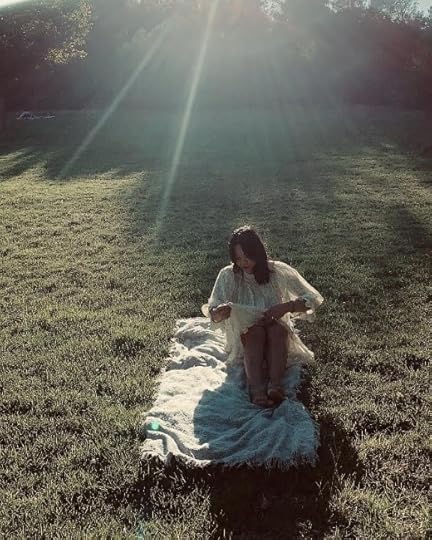
After working in the fashion industry for about a decade, Vuong made the decision to quit in June 2020 so she could focus on end-of-life care. “I was getting really curious about birthing doulas, just because I’m at an age where I’m likely to have children in the near future,” she explains. “Then somehow, I found an article about death doulas, so I started to research and completely fell in love … I reached out to my community and as a millennial, I relied on Instagram and the death doula hashtag.” Along the way, Vuong began following Tree Carr, a U.K.-based death doula who was serendipitously visiting Los Angeles when they connected. The two of them were able to meet for a coffee date, during which Carr provided Vuong with resources for her death care journey.
Vuong soon decided to begin volunteering for Silverado Hospice in Los Angeles, where she would routinely be a companion to patients. However, her involvement took a turn during a volunteer support group meeting when someone mentioned that at one point, there had been a floral program for patients. Though the program didn’t last because it was difficult finding and scheduling volunteers, it sparked something inside Vuong.
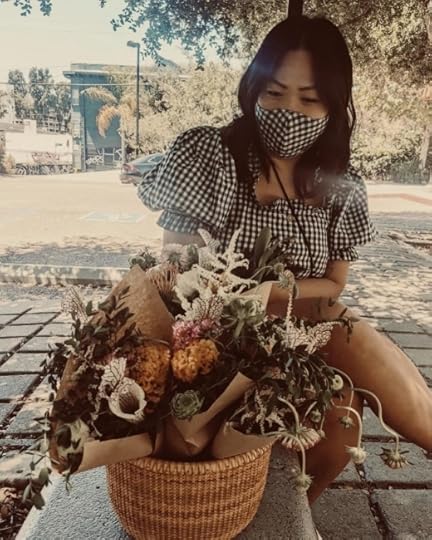
“To give you background on what was going on in my head during that meeting — in 2009 and 2014, I had surgery for ovarian issues. My friend, Karen, was working in production events at the time, and she would bring enormous floral arrangements to my house. She said they were throwing them away at work,” Vuong relays. “That’s when I really learned about how the events industry uses flowers for a couple of hours and at the end of the night, they go in the trash.” With this memory in mind, Vuong got the go-ahead from her hospice volunteer coordinator to run with the idea of a floral repurposing program.
It started off simple enough, with Vuong requesting leftover event florals on social media, but quickly grew into an initiative she called Guided by Flowers. “I would book as many events as I could and I would get paid very little because I wanted it to be attainable,” Vuong says, explaining how she would pick up the flowers, arrange them into small bouquets, and then gift those arrangements to hospice patients. “There are other floral repurposing companies out there that seem very corporate and [expensive] … I would more or less do it by donation, having people give whatever they wanted to give.” She continued to do this for the past two years, all while working in fashion and learning from other death doulas in Los Angeles.

However, Vuong’s trajectory relatably took a turn once the coronavirus pandemic hit. “As far as floral work, COVID-19 completely wiped my donations empty,” she explains. To adapt and continue her work as a self-taught, death community-driven florist, Vuong then made the decision to launch a Guided by Flowers shop service. The business model? “Buy one, gift one to hospice.” So instead of repurposing florals from events, Vuong sources flowers from the L.A. Flower District, creates a bouquet for her customer, and then designs a mini version that can be sent to a nearby hospice.
In addition to her shop program, Vuong recently orchestrated a “death over flowers” workshop with her friend Marifel, who is also involved in the death care community. “I think that flowers are a great example of the cycle of life, and they accompany us throughout so many different stages of our own lives … I think there’s a lot of healing in touching nature and arranging florals … so we wanted to marry the two things,” Vuong says. “What that looks like is anyone can sign up — even though space was limited, especially during the pandemic — and it was essentially getting together to make floor arrangements and talk about death. It’s not meant to be a grief support group, but people can and do cry. We’re creating a sacred space for anyone to engage and have a very human conversation.”

While Vuong wants to continue finding ways to be involved in the end-of-life care community, she’s not sure where she wants to take her death doula work. Currently, she’s interested in working as a pet death doula — she has two dogs of her own, Ham and Margot — and recently began working with a tech-forward veterinarian clinic called Modern Animal. “Because of everything that I’ve learned about how to serve humans as they die, I wanted to bring that to my pets,” Vuong states. “I hear about the way that people have to put down their pets — they get euthanized in a sterile environment and you don’t get to go home with them. I think it’s a very traumatic experience when it doesn’t have to be.” Instead, Vuong would like to guide and educate people on using alternative options, such as holding memorial services for their pets.
Overall, when speaking of the future, Vuong admits that (like many of us) she’s not sure where it will take her. She hopes to continue floral repurposing and volunteering for hospice when it’s safe again, but for now, she will continue investing in Guided by Flowers and learning more about being a pet death doula. Even with all these twists and turns, when speaking of her journey thus far, Vuong admits, “Looking back, I feel as though my life was meant to become this way.”
Anna Gragert. When Anna isn’t trying to create a groundbreaking third-person bio for herself, she’s working as a writer, editor, and content strategist. She was previously a deputy editor at So Yummy and the lifestyle editor at HelloGiggles, and has worked with publications such as Teen Vogue, Nylon, Dazed, LAist, Glamour, The Order of the Good Death, Bust, Catapult, and more. You can follow her @annagragert on social media.
September 26, 2020
The Massive LA Disaster You’ve Never Heard Of
September 18, 2020
The Unbreakable Spirits of Black Gospel During Funerals

1950s. Photograph by Anita Katherine Dennis.
From old church hymns to Negro spirituals, I’ll never forget being raised in the Black church. When I was about 9, I attended my first Black funeral, and hardly knew what to expect.
I thought it would be like the funerals on TV and everyone would wear black. However, my family was fast to tell me that this was definitely not the case, and it seldom is for the Black funeral.
They told me it would be long, that we weren’t required to wear black and there would be many speeches, a long sermon and most of all, lots of singing. Most of our regular church services had lots of songs and a long sermon, so I thought it may just be like one extra sad day of church, but I was wrong. People were singing so hard and passionately that it seemed like their lungs would give out. There were tears, but it wasn’t about sadness, we were celebrating a Homecoming, also known as a Homegoing, not a funeral. This was gospel and everything was mixed and blended with soul.
During slavery, Black people weren’t allowed to have formal ceremonies or rituals to mourn the dead, as slave masters viewed their gatherings as a sign that they were conspiring against them.
Yet, Black people sang spirituals which not only carried secret messages to help one another escape and find freedom, but also carried the souls of the ancestors that white society thought they had erased. While there may be lost paper trail histories, blood memory has always traced back to the soulful music of the Black church.
When African people were taken to America and enslaved, they believed that death meant their soul would return to their homelands in Africa. For them, death was freedom from a life of suffering and a pathway home to be with their ancestors. Thus, the Black community adopted our own form of Homecoming.
Homecoming transformed over time, and Black Americans have created funeral traditions that are celebrations of life. In many Black Christian churches, death is about reuniting with the loved ones, ancestors, God and Christ. It is viewed as a victory, but also a time to mourn if needed.
Most of the songs during Black funerals are old and traditional Black Christian hymns, contemporary music is seldom used. These older songs bring families back to their roots, in a way that is unique to awakening the nostalgia of home and Africa.
Songs are usually led by the choir members and the choir director which are either dressed in their choir robes or in formal attire, which varies from church to church. All attendees that can, are expected to stand and sing for each song, with singing lasting up to six hours in some cases.
The common gospel songs that are sung include, When We All Get to Heaven, Pass Me Not O Gentle Savior, I’ll Fly Away, Leaning on the Everlasting Arms, On Christ The Solid Rock, Amazing Grace and more.
Many people don’t realize it, but Black people don’t just sing, they move to the music during funerals; whether it’s a grandmother swaying to the music and clapping her hands or a younger person praise dancing, which is a worship dance that was inspired from the African tradition.

In His Presence Dance Ministry of Scott United Methodist Church Denver.
The death rituals in Africa are much like the Black American ones, and vice versa. There is singing and dancing to celebrate the life of whoever was lost. There is a sense of pride, sadness, unity and bittersweet joy as the lyrics heal the community and remind them of how far they’ve come.
Black American funeral traditions were born out of the ashes of African traditions that were seemingly eliminated during the diaspora. However, both Black American and African cultures have not only survived, they have flourished against all odds.
Both incorporate song and dance to celebrate a Homecoming that is centered around the family and how each person is interconnected. A popular African proverb that I, among many other Black American and African people, learned as a child was that, “It takes a village to raise a child,” and much like the funeral gatherings, it also takes a village to bring God’s children home.
Some of the popular African songs have echoed generations of various villages throughout many regions of the continent.
For instance, the Akan tribe of Ghana is known for Nnwonkoro songs. The book, Female Song Tradition and the Akon of Ghana by Kwasi Ampene, explains, “Nnwonkoro is a genre of women’s song found among the Akan-speaking peoples of Ghana. It has become a hybrid musical form, incorporating songs and dance movements based on traditional practices alongside others reflecting Christian influence.”
The combination of both traditional African themes with Christain influences reflects the impacts of colonization and apartheid that shaped how funerals would develop and transform over time for all African peoples and their descendenants around the world.
However, there are distinctions that allow each particular culture and tribe to maintain something inherently unique about their customs. For instance, West Africa is famous for its hour-glass shaped drum called a “talking drum.” The pitch and tone of the instrument resemble that of human speech very well.
With two drum heads, the instrumentalist can change pitches at either side for a distinct sound.The sounds of the drums are like human humming, hence the name “talking drums.”

Yoruba drummers, Ijomu Oro, Kwara State, Nigeria, in April 2004. Photo by Melvin Buddy Baker.
While these aren’t used as often in Black American funerals, in West Africa, there would simply be no funeral without them. The Yoruba people of Nigeria, Ghana, Togo and Benin call these drums “Dundun drums,” and upon being played, these drummers are always accompanied by singers.
While every day is an opportunity for song and music, during funerals, their music takes on new life. With a huge multiplicity of religious influences ranging from worshipping the deity Olodumare, to Christanity and Islam after colonization, the beliefs have remained expansive, and as a result, so has their music.With liveliness, color and soul, there is nothing like a Yoruba burial song.
While the music of Black American funerals and African funerals are alike in some ways and different in others, the truth remains, that no matter the brutality of life, in death the spirits within Black people will always live on.
As diasporic cultures remind us, for those born to the homeland of Africa, as well as those that were stolen away from it, Africa is all of ours to celebrate, to mourn and to fill with the soulful musical notes of the ancestors.
As a Black woman that was raised in the Black church, I can attest to the power of Black song, even though I’m not the most religious person, but I have the utmost faith in the powerful music of the Black spirit. Until the day that I die, I will always be singing the spirituals that my grandma taught me.
Danielle Broadway is an English Literature MA student at California State University, Long Beach. She has been published in Black Girl Nerds, LA Weekly, Cosmopolitan, Blavity and more, and is a writer and editor for CSULB’s Dig Magazine and an assistant editor at Angels Flight • literary west. She’s an activist and educator that is inspired by her family to make social change both in the classroom and beyond. Follow Danielle on Twitter, and Instagram.
September 15, 2020
Can I Keep My Parents’ Skulls & Tattoos?
September 4, 2020
Therapy, Mental Health, and Death Positivity
We live in a world where death is everywhere – and increasingly so; every day we turn on the news or open Twitter only to be met with brutal images of death, reminders of our mortality, and stories about how the end of life looms large in the decisions we make. There’s death at the grocery store and on the packages that come into our homes; there’s death at the voting booth and in refrigerated trucks parked outside of hospitals – images embedded in our consciousness.
This ubiquity is not unique to this particular moment in time, although it’s certainly more concentrated. It’s also at odds with, what is for many, a deeply death-phobic society which makes for our collective coping of grief an oft deeply flawed and fraught process.
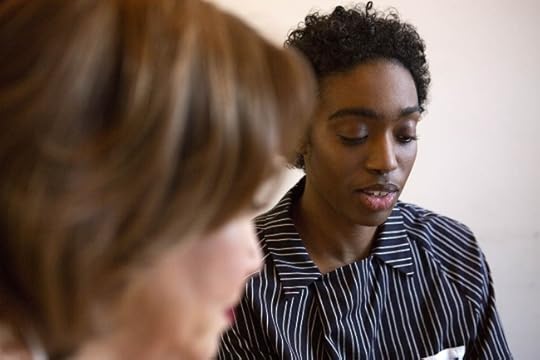
From the Gender Spectrum Collection, photos by Zackary Drucker.
The Death Positive Movement means a lot to me; as an acutely death phobic child, it took me a hearty dose of therapy after a death in the family to start to grasp the enormity of the concept. The first time I remember feeling even remotely comfortable being around and talking about death was when we learned about Ancient Egyptian funerary rituals in the 4th grade; I was rapt with the way they ritualized death, and their beliefs about the afterlife assuaged my childhood concerns about the finality and unknown of it all. Death Positivity is a movement that seeks to remove stigma and shame from conversations about death and grief; to be death positive is to understand that thinking about and talking about death are normal and that people experience death and grief in different ways. Having honest conversations about death fosters a healthy relationship with it. Death positivity radicalized my understanding of mortality, grief, and death; it also helped me contextualize my love of thriller and true crime as an outlet to cope with my medical trauma.
When I talk about the amazing impact death positivity has had on my life with friends and family the response is decidedly mixed; my family, once confused by why I was watching weekly videos about famous corpses and notorious crematorium disasters, now understand death positivity to be an incredibly nuanced and powerful outlet make the relationship I have with grief healthier and less traumatizing. But while telling your friends and family about death positivity is one thing, sharing this world with our medical providers – especially our therapists, can prove complicated, uncomfortable, and challenging.
My good friend Hayley Farless, a reproductive justice advocate, shared that she brought death positivity up in therapy to explain how it was helping her cope with witnessing an unexpected and very graphic death and the trauma resulting from that. “I was scared,” she says. “Therapists are people living in this society too, and even though they’re professionals with more tools for coping with death or grief, we can only assume they’ve absorbed the same ‘death is scary and bad and we have to be quiet about it’ mentality like the rest of us.”
She also said she was worried her embrace of death positivity could be misconstrued as a risk to her safety. “I’m a person with an anxiety disorder and clinical depression, and those conditions have a medical association with suicide. I was worried that I could be involuntarily hospitalized if my therapist were to misunderstand what death positivity is and think my life or my safety was at risk.”
Thankfully after some explanation, Farless feels her therapist heard her out and understood where she was coming from; she says the conversation was uncomfortable at times, but critical for her and her therapist moving forward in her care.
“It was really important to me to bring it up because death positivity and the acceptance of grief and the idea of a ‘good death’ are all so central to how I am coping with both the trauma that I experienced and my chronic depression,” she says. “…now she can better understand my perspective and provide care for me in a way that’s more meaningful to my thought process.”
Farless says death positivity can help us move towards a more sociocultural understanding of death. “There are many ways we can improve our inevitable deaths for ourselves, our families, our communities, and our planet if we’re just willing to actually engage with the idea of death.”
And these days, having a conversation about death positivity with your therapist might be more valuable than ever.

From the Gender Spectrum Collection, photos by Zackary Drucker.
“Everyone is facing death anxiety now, on a massive scale. What better, more rational time to engage your feelings about your own mortality?” says Doughty, Order of the Good Death founder, and a leader in the death positivity movement.
But how to approach them with the comfort and clarity needed for a productive outcome?
Doughty says first and foremost, “nothing should be off limits in your therapy sessions… There should never be a palpably negative reaction from a therapist to a discussion of death. If there is a negative reaction, it’s 100% not your fault.”
She suggests opening the conversation by asking if your therapist has heard of death positivity; if they haven’t she says asking a simple question can be a great jumping off point: “let them know that it’s a popular movement that claims shutting down and repressing conversations around death has had a negative effect on our society. Ask if they agree with that statement.”
Megan Devine is a Licensed Professional Counselor, grief advocate, and founder of Refuge in Grief; she says opening up to a therapist about exploring death positivity can be tricky, but there are ways to make the process smoother.
The two things main things to consider, she says, are the tone you bring to the conversation, and the possibility that your therapist might associate “death positivity” on its face with suicidality. She wrote a fantastic guide on how to navigate the latter, which you can read here.
“Sometimes our excitement and interest in death positivity can make us not as clear as we might be or as sensitive to the fact that this might be new for the provider in the room,” she says. Communicating with too much enthusiasm might convey the wrong idea about your investment in the topic. She also suggests opening with a question to discern how familiar your therapist is with death positivity and to gauge their reaction as a read on how open they may be to having a discussion about it. From there she says, try to summarize death positivity in what it means to you in a few short thoughts that are hard to misinterpret. “I would say something like, ‘To me, death positivity is simply being willing to talk about death and not shying away from the discomfort or the weirdness that comes up… Death positivity is finding ways to talk about death as a normal thing that we all experience.’”
You’re looking for “curiosity, instead of condemnation,”; every therapist is not going to be comfortable talking about grief or know about death positivity, but your therapist should indicate an openness to learn more and to understand why death positivity is important to you.
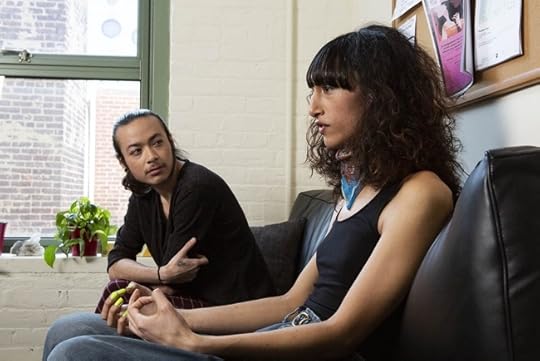
From the Gender Spectrum Collection, photos by Zackary Drucker.
“You have permission to fire a therapist who refuses to be curious about your experience,” she stresses. She also says if you find your therapist has a judgmental reaction to death positivity but you’ve worked with them for a while, you should also feel comfortable opening up a conversation with them about why that interaction was hurtful or uncomfortable for you and try to move forward with that understanding. What’s important – she says – is that you remember your therapist is there to help you and to meet your needs.
Talking about death in therapy, whether it’s weighing on us in an explicit way or not, has value. Devine explains that often, the root of all our fears is – at the end of the narrative: death. “There’s a school of thought in therapy that is like so, if somebody comes in and says, ‘I can’t do such and such,’ the therapist is supposed to say, ‘Why not?’ And then the person is like, ‘Because this, this, and this will happen.’ And then the therapist is supposed to say, ‘And then what?’” The answer at the end of all the and-then-what’s is almost always death. “In that sense, the fear of death is the foundational root of all distress and all decision making.”
Echoing Megan, Sarah Chavez, one of the founders of the death positivity movement, and the Executive Director of the Order, says the phrase “death positive” can need some unpacking with the unfamiliar, especially when people focus on the “positive” aspect of it. “They immediately jump to the conclusion that this indicates a desire to die, or that we’re dismissing the pain and grief that accompanies it or encouraging people to ‘look for the silver lining in death,’ but, of course none of this is true.”
She suggests using other, more easily recognizable movements with similar framing to help broach the topic with your therapist.
“I like to preface introductions to death positivity by first grounding the conversation in something that the other person may be familiar and comfortable with like Sex Positivity, or Body Positivity – movements that are also about open discussion, education, and self- awareness.”
“Death positivity is about life,” says Chavez. “Conversations about our mortality are not only critical to our mental health but our understanding of self, and how our fear of death underlies our behavior, beliefs, actions and the choices we make.”
For more helpful framing and facts about death positivity, and resources to share with your therapist if you’re inclined, Chavez suggests the Order’s website and FAQ page. There you’ll find an “outline of basic tenets, Its potential to change both ourselves and the world for the better, and help dismantle the roots of inequality, racism, and social marginalization.”
Caroline Reilly is a Boston-based reproductive justice advocate, recent law school graduate, and macabre maiden. She regularly contributes to a number of publications including Teen Vogue, the Washington Post, Bitch Media, and Rewire.News, writing about abortion access for young people, medical misogyny, sexual violence, and more. When she isn’t working she can be found watching British procedurals and parenting her neurotic Italian Greyhound, Rocko. Find her on Twitter @ms_creilly.
September 3, 2020
Girl Talk with the Dead!
August 8, 2020
The (Real) Delusion That You’re a Corpse
July 26, 2020
What the Waco Bodies Revealed About the Siege
Caitlin Doughty's Blog
- Caitlin Doughty's profile
- 8406 followers



